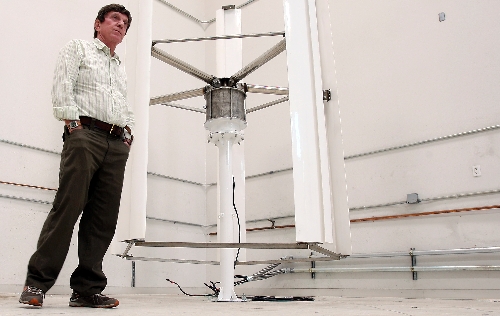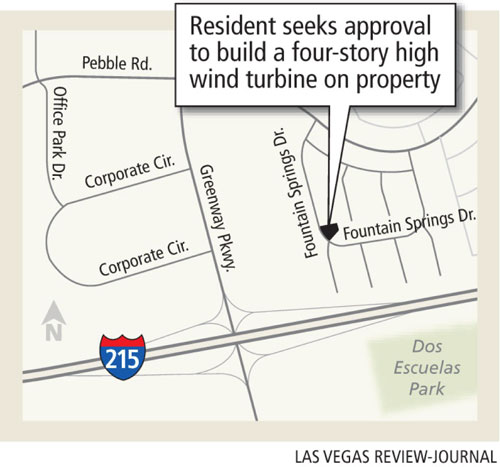Windmill plan unites neighbors
The place is called Green Valley, but it sure doesn't seem like it to Kermitt Waters.
The attorney and entrepreneur wants to put up a four-story wind turbine at his home near Green Valley Parkway and the Las Vegas Beltway.
So far, though, his backyard bid for renewable energy has met overwhelming resistance from neighbors and what Waters described as bureaucratic aggravation from the city of Henderson.
"Everybody wants to talk about green but nobody wants to do anything about it," he said. "We're never going to be energy independent until every house becomes a mini power station."
But to Waters' neighbors, the issue is far less global. They worry about what the wind turbine will look and sound like and what might happen if it should collapse.
Cami Putnam lives next door to Waters. If the 45-foot-tall structure he plans to build were to topple to the east, at least some of it would crash down in her yard.
The possibility scares her, since her five kids spend a lot of time playing outside.
"None of us has anything against green energy or saving our planet or anything like that," Putnam said. "It just doesn't belong here in a little community like this. It belongs somewhere else, on a one-acre lot somewhere."
Smack in the middle of the fight is the city, which figures to get sued no matter what it does.
"Right now, I don't see a lot of common ground. The neighbors absolutely don't want it, and he absolutely does," said City Councilman Steve Kirk.
Waters first applied for a city permit for his windmill in October. The Henderson Planning Commission turned him down in January, citing concerns over the structure's safety, height, noise and compatibility with the surrounding homes.
Waters appealed that decision to the City Council in February, but the matter was delayed until March 2, then delayed again until early June.
Dozens of Waters' neighbors turned out for the March 2 meeting, many of them sporting buttons that read, "I'm not a big fan; not in my neighborhood."
Mayor Andy Hafen apologized to them for postponing the matter, but he said city officials need more time to review all sides of the issue.
The city certainly supports green energy initiatives, Hafen said, but "we feel that this is going to be precedent-setting. We want to do it right."
Until Waters came along, Henderson Planning Manager Michael Tassi said the city had never received an application for a residential wind turbine.
As a result, he said, the city "didn't have anything on the books" for regulating alternative energy generation at homes in Henderson.
The city has since fixed that, enacting a new ordinance March 1 that spells out the rules and the approval process for windmills and solar panels.
But Waters feels like he's being singled out, that the city is writing restrictions specifically to block his plans.
He said the whole structure should have cost him about $5,000 including installation, but all the city's questions have forced him to shell out an additional $35,000 so far on lawyers, structural engineers and other experts.
All this, Waters said, despite the fact that his turbine is no higher than a palm tree or an amateur radio antenna, neither of which require public hearings and special-use permits.
Waters' Windmill, as it has come to be known, is a vertical axis wind turbine. It resembles a giant eggbeater stood on end.
At the moment, the business end of the structure -- basically the spinning top minus the 35-foot pole Waters plans to mount it on -- is on display inside a warehouse about five miles from the house in Green Valley.
Waters had it assembled there so it could be tested and people could get a look at it.
The turbine stands about 10 feet tall and 7 feet in diameter. It uses magnetic-levitation technology in its main bearing, allowing its carbon fiber blades to spin with far less noise than more traditional horizontal windmills.
Waters said his unit is the safest, quietest and least obtrusive one of its size on the market.
"If they don't approve this one, nobody else need apply," he said.
Waters has a much larger wind turbine generating power at his 10,000-acre ranch in the Texas panhandle, where he eventually hopes to develop a commercial wind farm. "All we need is about $250 million," he said with a smile.
UNLV professor and wind energy researcher Darrell Pepper has taken a keen interest in what Waters is doing.
Some of Pepper's mechanical engineering students helped Waters assemble and test his turbine, and Peppers is already tinkering with a few ideas for improving its efficiency.
He said it remains to be seen if Waters' neighborhood is windy enough for the turbine to work properly, but he believes the design has definite residential applications.
It won't supply all the power a house needs, but it could significantly cut someone's power bill.
"I can tell you what's going to happen. The minute we put this up people are going to be asking where they can get one," Pepper said. "Remember, these things run at night. Solar only works about 50 percent of the time no matter how efficient it is."
If the market takes off for small wind turbines at homes and businesses, Pepper hinted that he and Waters might team up with some investors and start manufacturing the units here.
Right now, though, all the focus is on the getting the first windmill up in Green Valley.
Waters' house sits at the corner of Crown Valley Drive and Sapphire Valley Avenue, two quiet streets lined with tightly grouped five-bedroom homes, each built on less than a quarter of an acre.
Waters said he bought the place as an investment in 1991, and now he stays there whenever he's in town, which is only about "half the time."
His neighbors insist he doesn't really live there at all.
According to Putnam, Waters' house has not been occupied for more than a week at a time in all the years her family has lived next door. Every now and then, someone from the neighborhood will clear the newspapers and advertising fliers from in front of the residence so it doesn't become a target for burglars, she said.
"He's been my neighbor for nine years, and I saw him for the first time that night at the City Council meeting," Putnam said.
This is an especially galling subject in the neighborhood, because many of the people living there full time see Waters' Windmill as a thinly veiled commercial venture that could drive down their property values.
To counter that, Waters offers up an affidavit from a real estate expert who says just the opposite, that green energy improvements actually increase home values.
Ultimately, Kirk said, questions about Waters' residency or his motives aren't really relevant to the decision now facing the council. "It may not be what the neighbors are defining as being a good neighbor, but it's his right (to put up the windmill) if this fits within the design code," he said. "I don't know what we can really do about it."
Kirk added that he is still researching the issue. He won't make up his mind until he goes to see the windmill and hears more from the surrounding residents.
Putnam said she and her neighbors already have discussed the possibility of a lawsuit should the council clear Waters to proceed.
"I have to thank Mr. Waters for one thing," she said. "He's united us as a neighborhood."
Waters promised a lawsuit of his own if things don't go his way. "I've already gone this far. I might as well go the whole nine yards," he said with a Texas drawl.
Both Clark County and the city of Las Vegas also have rules in place for wind turbines, solar panels and other small-scale power generating units.
Neither entity reports any serious conflicts, though county spokesman Dan Kulin said several applications for windmills have come up in the past year.
In September, a plan for a 137-foot wind turbine in a rural area north of Southern Highlands was withdrawn by the applicant after county planners recommended against it.
In December, the county granted permission for a 51-foot wind turbine at the Searchlight home of U.S. Senate Majority Leader Harry Reid.
Jon Summers, spokesman for Reid, said the turbine isn't up and running yet, but it should be in a matter of days.
Combined with the solar panels Reid had installed last year, the turbine is expected to completely offset the home's energy needs.
"Senator Reid thinks it's important that we all do our part, individually and as a state and nation, to take cost-effective actions to reduce pollution and become more energy independent," Summers said.
As far as Waters is concerned, that is exactly what he is trying to do.
If he eventually wins permission to put his windmill up, he said he will probably buy more of them for his other properties in the valley, including his office near Sahara Avenue and Paradise Road.
Much to the dismay of those living around him, Waters also plans one day to replace his backyard turbine with a wider version capable of generating almost twice as much power.
Waters said the larger windmill is sitting in a box in his garage right now.
Contact reporter Henry Brean at hbrean
@reviewjournal.com or 702-383-0350.


















